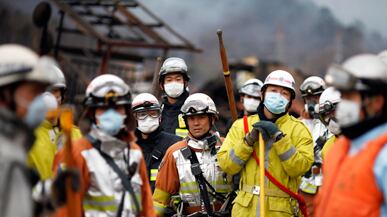Japan briefly evacuated workers the Fukushima Daiichi Nuclear Plant on Wednesday when radiation levels peaked, thanks to a breach in the containment vessel at a second reactor. In a desperate measure, the Defense Ministry was preparing to have helicopters drop water on the reactor, but even that has proven impossible due to high radiation levels. Meanwhile, France has urged its citizens to leave Tokyo, and Australia announced it is moving its embassy out of Tokyo to the western city of Osaka. Japan’s Emperor Akhito also gave his first address about the crisis Wednesday, saying he was “deeply worried” about the nuclear situation.
Panicked Americans are hunting down potassium iodide, frightened that dangerous radiation released from Japan’s Fukushima Daiichi power station will drift to the West Coast. Nuclear experts tell Josh Dzieza why that’s unlikely—and who’s most at risk. Plus, full coverage of the Japan disaster.
A cruel text message prank warning of a radioactive cloud heading toward the Philippines prompted Manila’s Polytechnic University to shut down, while Russian military units based on Sakhalin and the Kuril Islands north of Japan prepared to evacuate. Even in the United States, people are buying potassium iodide and crying when they’re told it’s sold out. The panic is understandable but unwarranted.

Death by radiation can be protracted and excruciating. It damages rapidly dividing cells—hair, stomach lining, bone marrow—so that even after the short-term symptoms of nausea and fatigue fade, far more serious problems take their place. Slowly, the body succumbs to illnesses it lacks the resources to fend off, or develops cancer from damaged DNA. Compounding the inherent scariness of radiation is the fact that one can be exposed to it in so many different ways: Particles can fall on skin or clothes and irradiate a person externally, which is why Japanese authorities told people to stay inside and close their windows. Or the particles can be inhaled, which is why people were told to cover their mouths with wet cloth. Or they can be ingested through food or water. Given such a threat, it’s no wonder that people as far away as California would worry. Fortunately, there seems to be little risk that dangerous levels of contamination from Japan’s stricken reactors will leave the country, or even the 12-mile evacuation zone.
The 50 workers who stayed in the reactor “are the people who are in my mind are unbelievably heroic,” said Brenner, “and the outlook for them is potentially not good.”
How far radiation from the Fukushima reactors will spread depends on how much is being emitted—right now, the amount seems to be declining—and on the wind. Even in Chernobyl, said David Brenner, head of Columbia University’s Center for Radiological Research, a person could be quite close to the reactor in the northwest direction and be safe. It was a totally different story if a person was to the southeast. Right now the wind is blowing offshore, but even if it shifted, Brenner said the 12-mile evacuation zone ought to keep most people safe, and chances of dangerous levels of radiation reaching Tokyo, a hundred miles away, are extremely low.
As for buying iodide in the United States, Brenner said he agrees with the health agencies of California, Washington State, and the Nuclear Regulatory Commission that it’s an overreaction. To put things in perspective, Chernobyl was a far worse disaster than Daiichi ever could be—Chernobyl was going full-bore when it exploded, it had no containment vessel, and it was an extremely flammable graphite pile reactor, so there was far more airborne contamination—and still it had no health effects in the United Kingdom, 1,000 miles from the site. The West Coast of the United States is 5,000 to 6,000 miles from Japan. Any radioactive particles that reached the coast would be too dispersed to pose a risk.
Not that radiation won’t be detected there. Radioactive particles will spread around the world, and highly sensitive detectors, many of them designed to check whether countries are abiding by nuclear weapons treaties, will be able to measure them. Just because the radiation can be measured doesn’t mean there’s enough of it to be dangerous, though. According to Brenner, airborne particles will probably be too dispersed to have health effects outside the 12-mile evacuation zone, and almost certainly won’t pose a threat outside Japan.
Testing food might be justified, however, as Hong Kong, Singapore, Malaysia, and South Korea have all said they plan to do. University of Illinois nuclear engineer Barclay Jones described how the Windscale reactor in England salted the surrounding grass with radioactive particles, which were eaten by cows and made their way into the milk. Some radioactive particles in the core are dangerous for a long time—strontium and cesium have half-lives of 30 years, iodine’s is eight days. In strontium’s case, it is chemically similar to calcium, so when it’s ingested in milk it goes to the bone. Both Jones and Brenner said there doesn’t seem to be enough radiation leaving the plant to pose this sort of risk. Still, Brenner said, “I wouldn’t be eating an apple that was grown inside the evacuation zone.”
The people to worry about are the 50 workers who stayed in the reactor. Where the general population might get exposed to radiation by inhaling or eating radioactive particles, or by having those particles fall on their skin, the workers who stayed behind are being bombarded with gamma rays directly from the reactor. “These are the people who are in my mind are unbelievably heroic,” said Brenner, “and the outlook for them is potentially not good.” They are at risk of full-on radiation sickness. The initial symptoms of nausea, diarrhea, and rashes are unpleasant, but the real effects don’t appear for weeks, as the radiation damages the body’s ability to replace cells and the bone marrow and stomach lining begin to weaken. “They’re the heroes of this story,” said Brenner.
Josh Dzieza is an editorial assistant at The Daily Beast.






